HI6026 Audit Assurance & Compliance: Auditor Reporting in Australia
VerifiedAdded on 2023/06/04
|16
|3754
|461
Report
AI Summary
This report provides a detailed analysis of the audit of Life Style Communities Limited, focusing on Pitcher Partners' audit work and compliance with Australian auditing standards. It covers the auditor's declaration of independence, the independent auditor's report and opinion, non-audit services performed, and an analysis of auditor remuneration. Key audit matters, particularly the valuation of investment properties, are discussed, along with the role of the audit committee and the responsibilities of directors and management. The report also addresses subsequent events and the effectiveness of information reported in audit reports. Desklib offers a wealth of similar solved assignments and past papers for students.
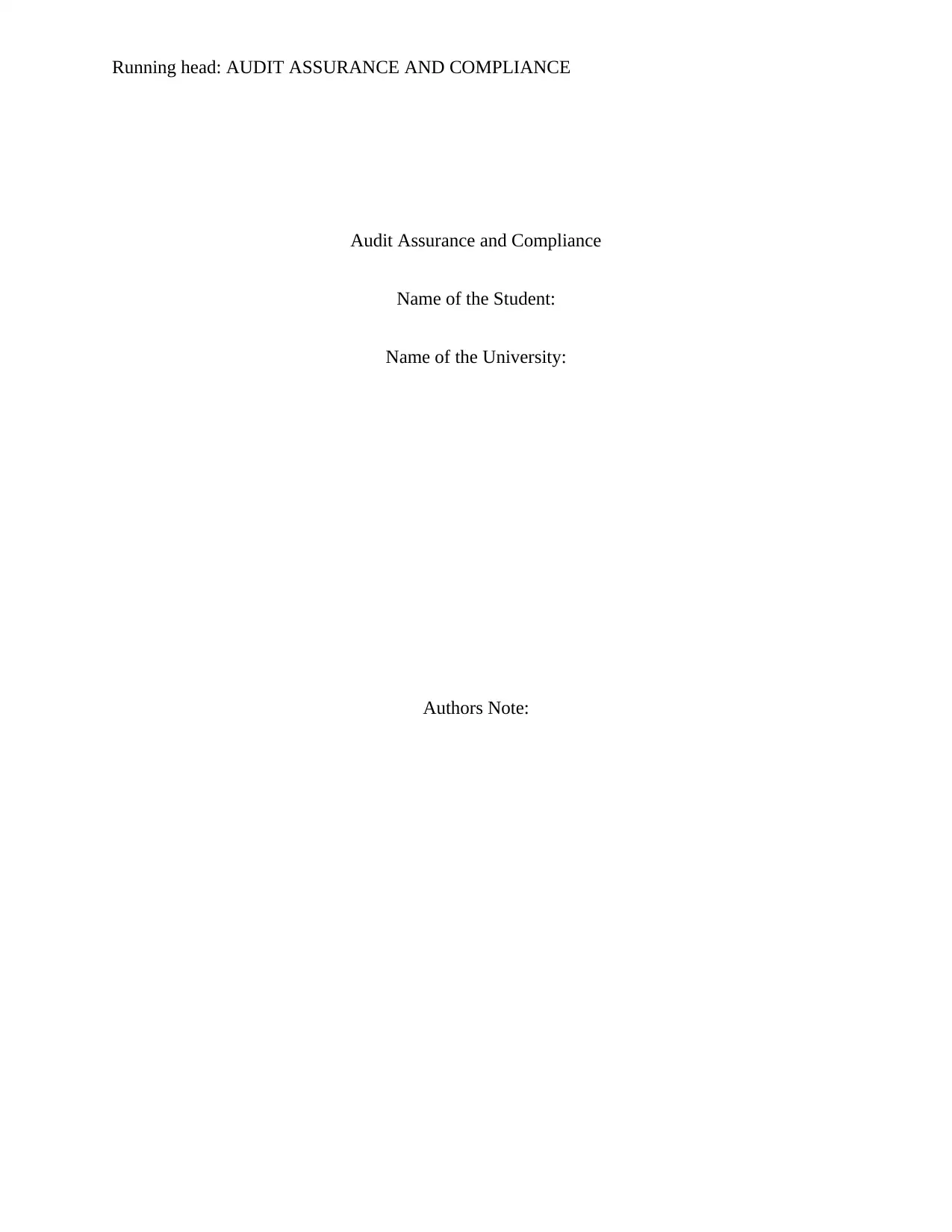
Running head: AUDIT ASSURANCE AND COMPLIANCE
Audit Assurance and Compliance
Name of the Student:
Name of the University:
Authors Note:
Audit Assurance and Compliance
Name of the Student:
Name of the University:
Authors Note:
Paraphrase This Document
Need a fresh take? Get an instant paraphrase of this document with our AI Paraphraser
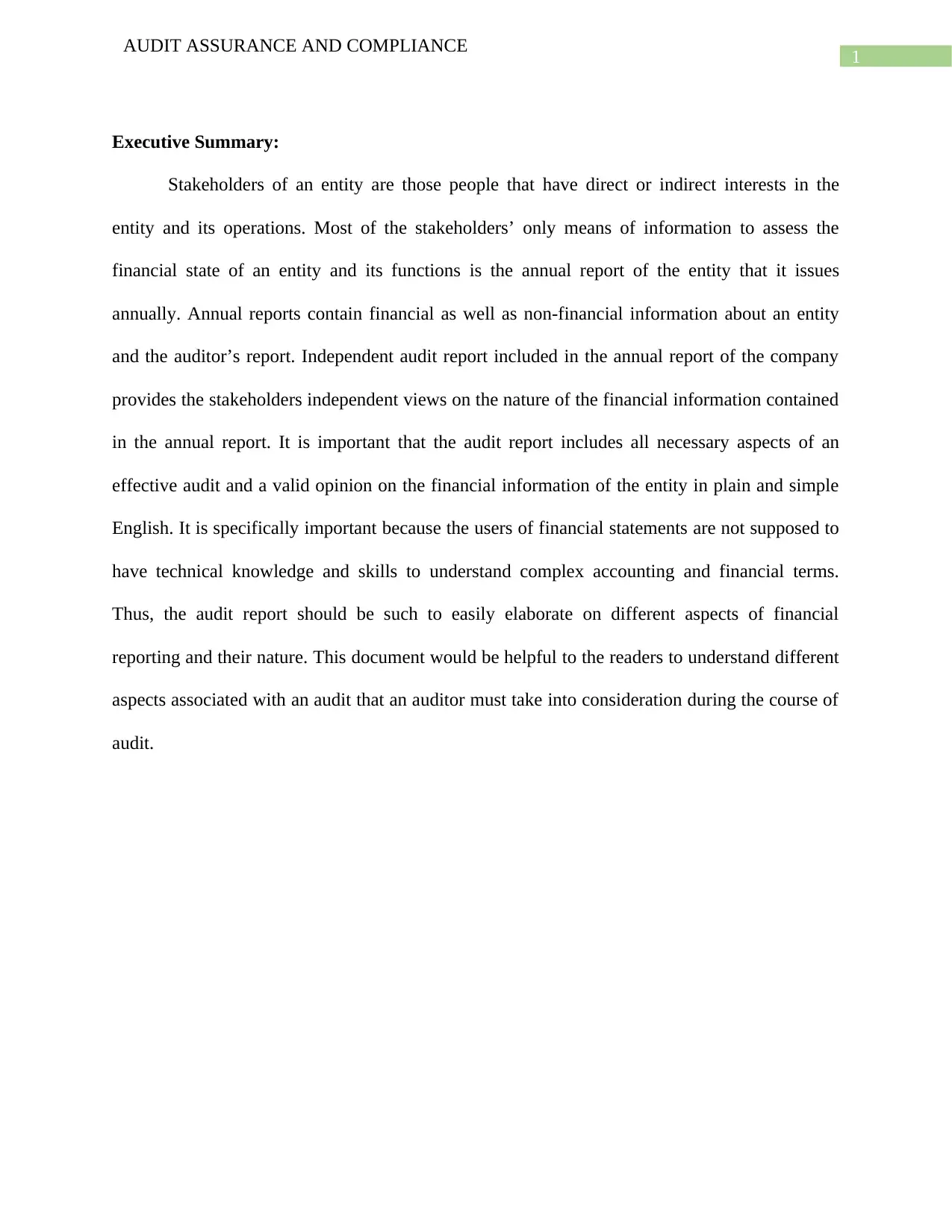
1
AUDIT ASSURANCE AND COMPLIANCE
Executive Summary:
Stakeholders of an entity are those people that have direct or indirect interests in the
entity and its operations. Most of the stakeholders’ only means of information to assess the
financial state of an entity and its functions is the annual report of the entity that it issues
annually. Annual reports contain financial as well as non-financial information about an entity
and the auditor’s report. Independent audit report included in the annual report of the company
provides the stakeholders independent views on the nature of the financial information contained
in the annual report. It is important that the audit report includes all necessary aspects of an
effective audit and a valid opinion on the financial information of the entity in plain and simple
English. It is specifically important because the users of financial statements are not supposed to
have technical knowledge and skills to understand complex accounting and financial terms.
Thus, the audit report should be such to easily elaborate on different aspects of financial
reporting and their nature. This document would be helpful to the readers to understand different
aspects associated with an audit that an auditor must take into consideration during the course of
audit.
AUDIT ASSURANCE AND COMPLIANCE
Executive Summary:
Stakeholders of an entity are those people that have direct or indirect interests in the
entity and its operations. Most of the stakeholders’ only means of information to assess the
financial state of an entity and its functions is the annual report of the entity that it issues
annually. Annual reports contain financial as well as non-financial information about an entity
and the auditor’s report. Independent audit report included in the annual report of the company
provides the stakeholders independent views on the nature of the financial information contained
in the annual report. It is important that the audit report includes all necessary aspects of an
effective audit and a valid opinion on the financial information of the entity in plain and simple
English. It is specifically important because the users of financial statements are not supposed to
have technical knowledge and skills to understand complex accounting and financial terms.
Thus, the audit report should be such to easily elaborate on different aspects of financial
reporting and their nature. This document would be helpful to the readers to understand different
aspects associated with an audit that an auditor must take into consideration during the course of
audit.
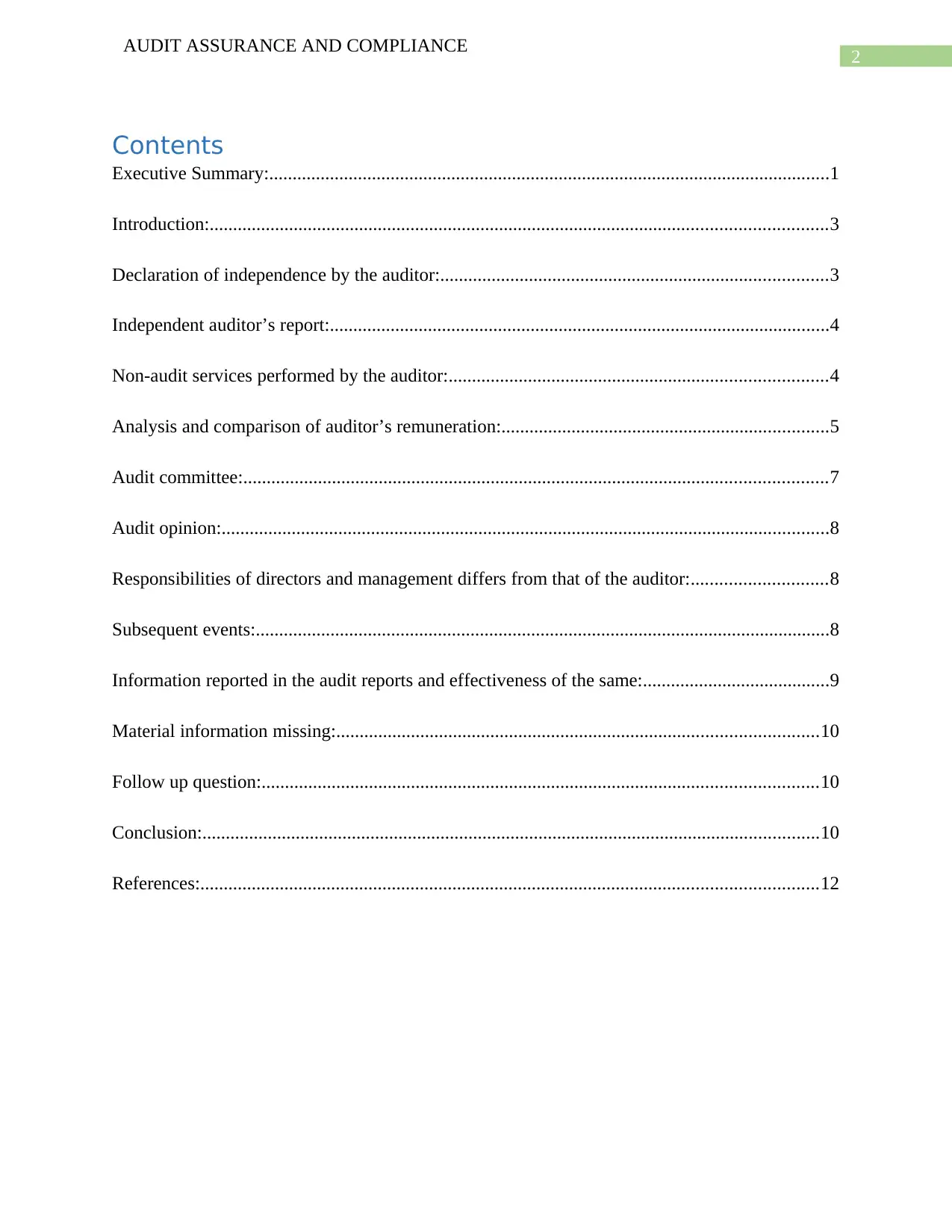
2
AUDIT ASSURANCE AND COMPLIANCE
Contents
Executive Summary:........................................................................................................................1
Introduction:....................................................................................................................................3
Declaration of independence by the auditor:...................................................................................3
Independent auditor’s report:...........................................................................................................4
Non-audit services performed by the auditor:.................................................................................4
Analysis and comparison of auditor’s remuneration:......................................................................5
Audit committee:.............................................................................................................................7
Audit opinion:..................................................................................................................................8
Responsibilities of directors and management differs from that of the auditor:.............................8
Subsequent events:...........................................................................................................................8
Information reported in the audit reports and effectiveness of the same:........................................9
Material information missing:.......................................................................................................10
Follow up question:.......................................................................................................................10
Conclusion:....................................................................................................................................10
References:....................................................................................................................................12
AUDIT ASSURANCE AND COMPLIANCE
Contents
Executive Summary:........................................................................................................................1
Introduction:....................................................................................................................................3
Declaration of independence by the auditor:...................................................................................3
Independent auditor’s report:...........................................................................................................4
Non-audit services performed by the auditor:.................................................................................4
Analysis and comparison of auditor’s remuneration:......................................................................5
Audit committee:.............................................................................................................................7
Audit opinion:..................................................................................................................................8
Responsibilities of directors and management differs from that of the auditor:.............................8
Subsequent events:...........................................................................................................................8
Information reported in the audit reports and effectiveness of the same:........................................9
Material information missing:.......................................................................................................10
Follow up question:.......................................................................................................................10
Conclusion:....................................................................................................................................10
References:....................................................................................................................................12
⊘ This is a preview!⊘
Do you want full access?
Subscribe today to unlock all pages.

Trusted by 1+ million students worldwide
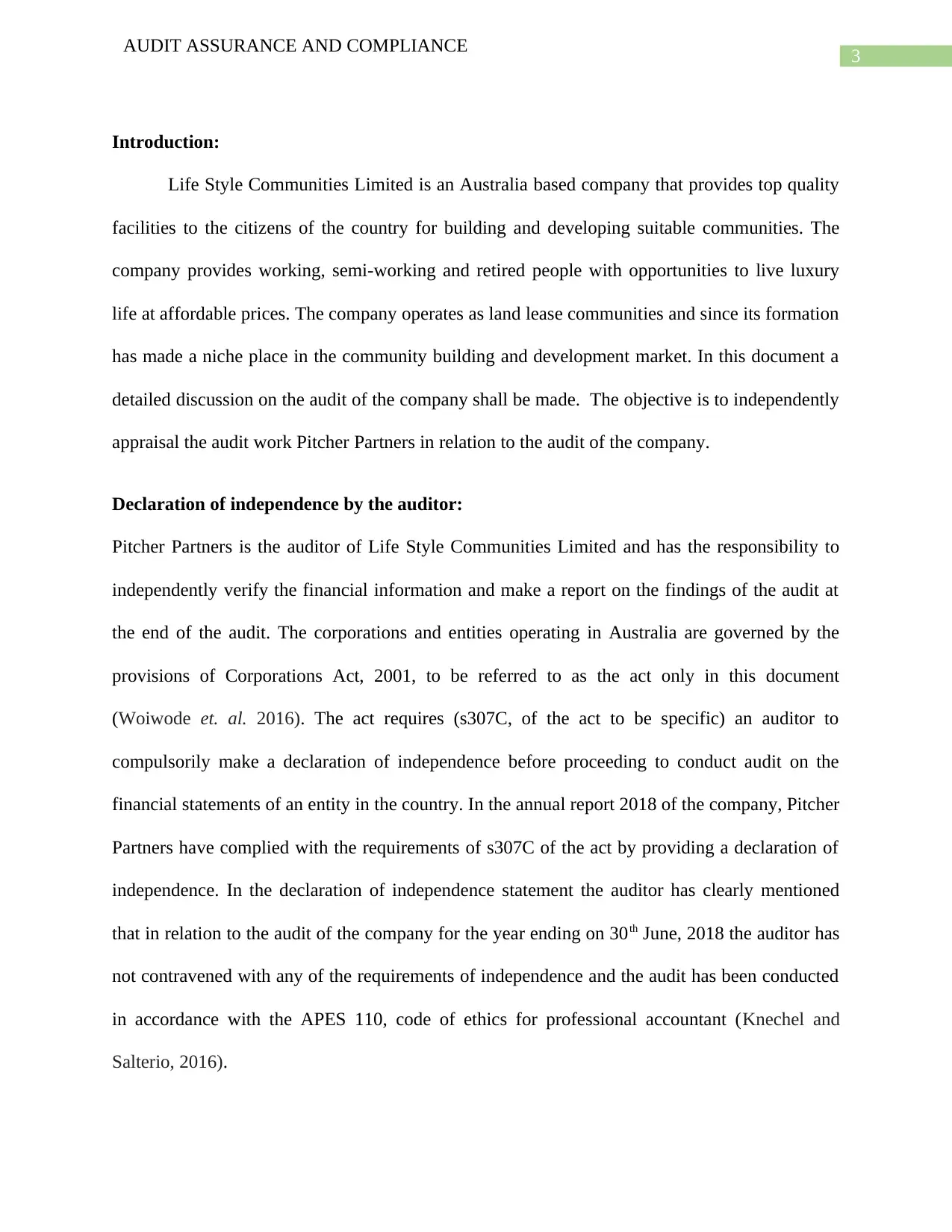
3
AUDIT ASSURANCE AND COMPLIANCE
Introduction:
Life Style Communities Limited is an Australia based company that provides top quality
facilities to the citizens of the country for building and developing suitable communities. The
company provides working, semi-working and retired people with opportunities to live luxury
life at affordable prices. The company operates as land lease communities and since its formation
has made a niche place in the community building and development market. In this document a
detailed discussion on the audit of the company shall be made. The objective is to independently
appraisal the audit work Pitcher Partners in relation to the audit of the company.
Declaration of independence by the auditor:
Pitcher Partners is the auditor of Life Style Communities Limited and has the responsibility to
independently verify the financial information and make a report on the findings of the audit at
the end of the audit. The corporations and entities operating in Australia are governed by the
provisions of Corporations Act, 2001, to be referred to as the act only in this document
(Woiwode et. al. 2016). The act requires (s307C, of the act to be specific) an auditor to
compulsorily make a declaration of independence before proceeding to conduct audit on the
financial statements of an entity in the country. In the annual report 2018 of the company, Pitcher
Partners have complied with the requirements of s307C of the act by providing a declaration of
independence. In the declaration of independence statement the auditor has clearly mentioned
that in relation to the audit of the company for the year ending on 30th June, 2018 the auditor has
not contravened with any of the requirements of independence and the audit has been conducted
in accordance with the APES 110, code of ethics for professional accountant (Knechel and
Salterio, 2016).
AUDIT ASSURANCE AND COMPLIANCE
Introduction:
Life Style Communities Limited is an Australia based company that provides top quality
facilities to the citizens of the country for building and developing suitable communities. The
company provides working, semi-working and retired people with opportunities to live luxury
life at affordable prices. The company operates as land lease communities and since its formation
has made a niche place in the community building and development market. In this document a
detailed discussion on the audit of the company shall be made. The objective is to independently
appraisal the audit work Pitcher Partners in relation to the audit of the company.
Declaration of independence by the auditor:
Pitcher Partners is the auditor of Life Style Communities Limited and has the responsibility to
independently verify the financial information and make a report on the findings of the audit at
the end of the audit. The corporations and entities operating in Australia are governed by the
provisions of Corporations Act, 2001, to be referred to as the act only in this document
(Woiwode et. al. 2016). The act requires (s307C, of the act to be specific) an auditor to
compulsorily make a declaration of independence before proceeding to conduct audit on the
financial statements of an entity in the country. In the annual report 2018 of the company, Pitcher
Partners have complied with the requirements of s307C of the act by providing a declaration of
independence. In the declaration of independence statement the auditor has clearly mentioned
that in relation to the audit of the company for the year ending on 30th June, 2018 the auditor has
not contravened with any of the requirements of independence and the audit has been conducted
in accordance with the APES 110, code of ethics for professional accountant (Knechel and
Salterio, 2016).
Paraphrase This Document
Need a fresh take? Get an instant paraphrase of this document with our AI Paraphraser
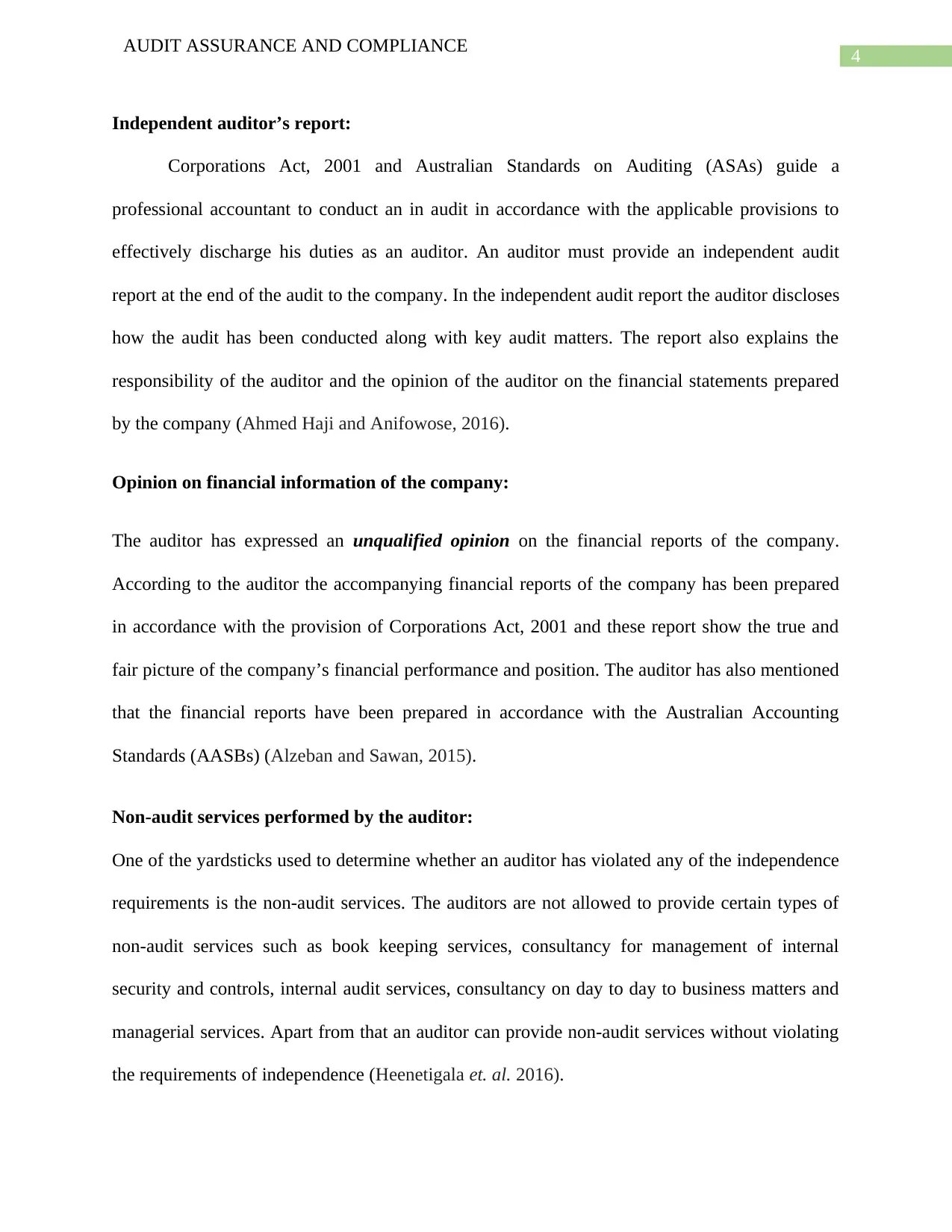
4
AUDIT ASSURANCE AND COMPLIANCE
Independent auditor’s report:
Corporations Act, 2001 and Australian Standards on Auditing (ASAs) guide a
professional accountant to conduct an in audit in accordance with the applicable provisions to
effectively discharge his duties as an auditor. An auditor must provide an independent audit
report at the end of the audit to the company. In the independent audit report the auditor discloses
how the audit has been conducted along with key audit matters. The report also explains the
responsibility of the auditor and the opinion of the auditor on the financial statements prepared
by the company (Ahmed Haji and Anifowose, 2016).
Opinion on financial information of the company:
The auditor has expressed an unqualified opinion on the financial reports of the company.
According to the auditor the accompanying financial reports of the company has been prepared
in accordance with the provision of Corporations Act, 2001 and these report show the true and
fair picture of the company’s financial performance and position. The auditor has also mentioned
that the financial reports have been prepared in accordance with the Australian Accounting
Standards (AASBs) (Alzeban and Sawan, 2015).
Non-audit services performed by the auditor:
One of the yardsticks used to determine whether an auditor has violated any of the independence
requirements is the non-audit services. The auditors are not allowed to provide certain types of
non-audit services such as book keeping services, consultancy for management of internal
security and controls, internal audit services, consultancy on day to day to business matters and
managerial services. Apart from that an auditor can provide non-audit services without violating
the requirements of independence (Heenetigala et. al. 2016).
AUDIT ASSURANCE AND COMPLIANCE
Independent auditor’s report:
Corporations Act, 2001 and Australian Standards on Auditing (ASAs) guide a
professional accountant to conduct an in audit in accordance with the applicable provisions to
effectively discharge his duties as an auditor. An auditor must provide an independent audit
report at the end of the audit to the company. In the independent audit report the auditor discloses
how the audit has been conducted along with key audit matters. The report also explains the
responsibility of the auditor and the opinion of the auditor on the financial statements prepared
by the company (Ahmed Haji and Anifowose, 2016).
Opinion on financial information of the company:
The auditor has expressed an unqualified opinion on the financial reports of the company.
According to the auditor the accompanying financial reports of the company has been prepared
in accordance with the provision of Corporations Act, 2001 and these report show the true and
fair picture of the company’s financial performance and position. The auditor has also mentioned
that the financial reports have been prepared in accordance with the Australian Accounting
Standards (AASBs) (Alzeban and Sawan, 2015).
Non-audit services performed by the auditor:
One of the yardsticks used to determine whether an auditor has violated any of the independence
requirements is the non-audit services. The auditors are not allowed to provide certain types of
non-audit services such as book keeping services, consultancy for management of internal
security and controls, internal audit services, consultancy on day to day to business matters and
managerial services. Apart from that an auditor can provide non-audit services without violating
the requirements of independence (Heenetigala et. al. 2016).
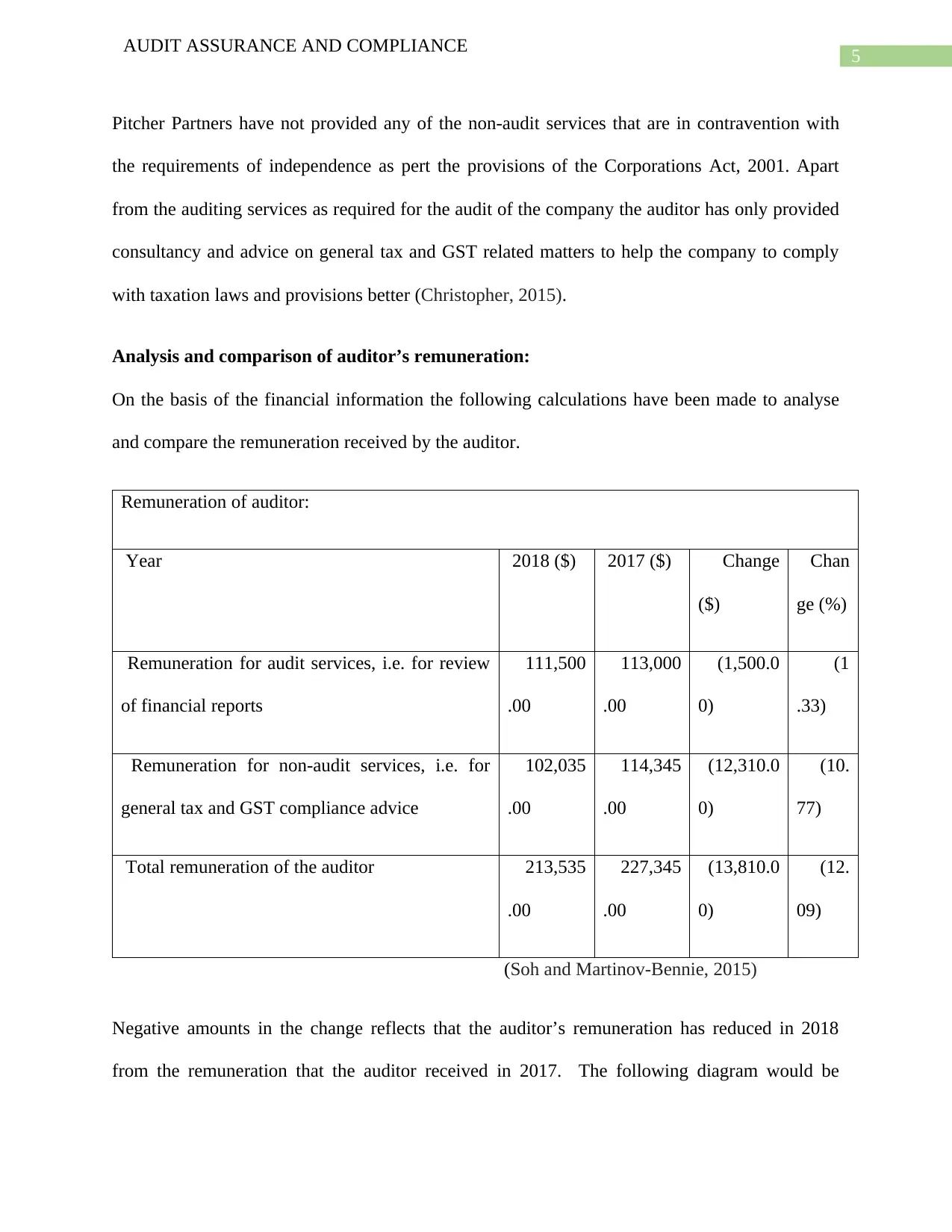
5
AUDIT ASSURANCE AND COMPLIANCE
Pitcher Partners have not provided any of the non-audit services that are in contravention with
the requirements of independence as pert the provisions of the Corporations Act, 2001. Apart
from the auditing services as required for the audit of the company the auditor has only provided
consultancy and advice on general tax and GST related matters to help the company to comply
with taxation laws and provisions better (Christopher, 2015).
Analysis and comparison of auditor’s remuneration:
On the basis of the financial information the following calculations have been made to analyse
and compare the remuneration received by the auditor.
Remuneration of auditor:
Year 2018 ($) 2017 ($) Change
($)
Chan
ge (%)
Remuneration for audit services, i.e. for review
of financial reports
111,500
.00
113,000
.00
(1,500.0
0)
(1
.33)
Remuneration for non-audit services, i.e. for
general tax and GST compliance advice
102,035
.00
114,345
.00
(12,310.0
0)
(10.
77)
Total remuneration of the auditor 213,535
.00
227,345
.00
(13,810.0
0)
(12.
09)
(Soh and Martinov-Bennie, 2015)
Negative amounts in the change reflects that the auditor’s remuneration has reduced in 2018
from the remuneration that the auditor received in 2017. The following diagram would be
AUDIT ASSURANCE AND COMPLIANCE
Pitcher Partners have not provided any of the non-audit services that are in contravention with
the requirements of independence as pert the provisions of the Corporations Act, 2001. Apart
from the auditing services as required for the audit of the company the auditor has only provided
consultancy and advice on general tax and GST related matters to help the company to comply
with taxation laws and provisions better (Christopher, 2015).
Analysis and comparison of auditor’s remuneration:
On the basis of the financial information the following calculations have been made to analyse
and compare the remuneration received by the auditor.
Remuneration of auditor:
Year 2018 ($) 2017 ($) Change
($)
Chan
ge (%)
Remuneration for audit services, i.e. for review
of financial reports
111,500
.00
113,000
.00
(1,500.0
0)
(1
.33)
Remuneration for non-audit services, i.e. for
general tax and GST compliance advice
102,035
.00
114,345
.00
(12,310.0
0)
(10.
77)
Total remuneration of the auditor 213,535
.00
227,345
.00
(13,810.0
0)
(12.
09)
(Soh and Martinov-Bennie, 2015)
Negative amounts in the change reflects that the auditor’s remuneration has reduced in 2018
from the remuneration that the auditor received in 2017. The following diagram would be
⊘ This is a preview!⊘
Do you want full access?
Subscribe today to unlock all pages.

Trusted by 1+ million students worldwide
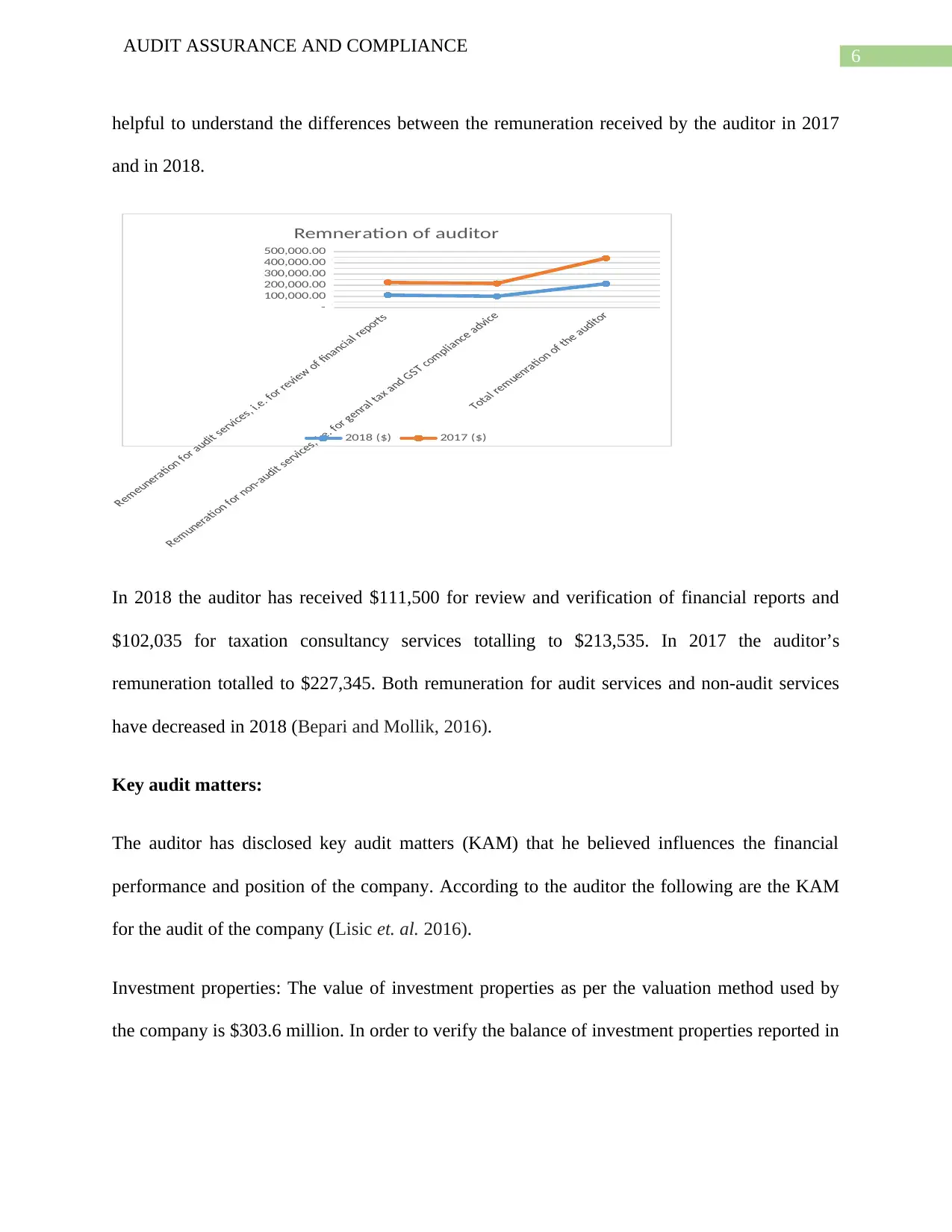
6
AUDIT ASSURANCE AND COMPLIANCE
helpful to understand the differences between the remuneration received by the auditor in 2017
and in 2018.
-
100,000.00
200,000.00
300,000.00
400,000.00
500,000.00
Remneration of auditor
2018 ($) 2017 ($)
In 2018 the auditor has received $111,500 for review and verification of financial reports and
$102,035 for taxation consultancy services totalling to $213,535. In 2017 the auditor’s
remuneration totalled to $227,345. Both remuneration for audit services and non-audit services
have decreased in 2018 (Bepari and Mollik, 2016).
Key audit matters:
The auditor has disclosed key audit matters (KAM) that he believed influences the financial
performance and position of the company. According to the auditor the following are the KAM
for the audit of the company (Lisic et. al. 2016).
Investment properties: The value of investment properties as per the valuation method used by
the company is $303.6 million. In order to verify the balance of investment properties reported in
AUDIT ASSURANCE AND COMPLIANCE
helpful to understand the differences between the remuneration received by the auditor in 2017
and in 2018.
-
100,000.00
200,000.00
300,000.00
400,000.00
500,000.00
Remneration of auditor
2018 ($) 2017 ($)
In 2018 the auditor has received $111,500 for review and verification of financial reports and
$102,035 for taxation consultancy services totalling to $213,535. In 2017 the auditor’s
remuneration totalled to $227,345. Both remuneration for audit services and non-audit services
have decreased in 2018 (Bepari and Mollik, 2016).
Key audit matters:
The auditor has disclosed key audit matters (KAM) that he believed influences the financial
performance and position of the company. According to the auditor the following are the KAM
for the audit of the company (Lisic et. al. 2016).
Investment properties: The value of investment properties as per the valuation method used by
the company is $303.6 million. In order to verify the balance of investment properties reported in
Paraphrase This Document
Need a fresh take? Get an instant paraphrase of this document with our AI Paraphraser
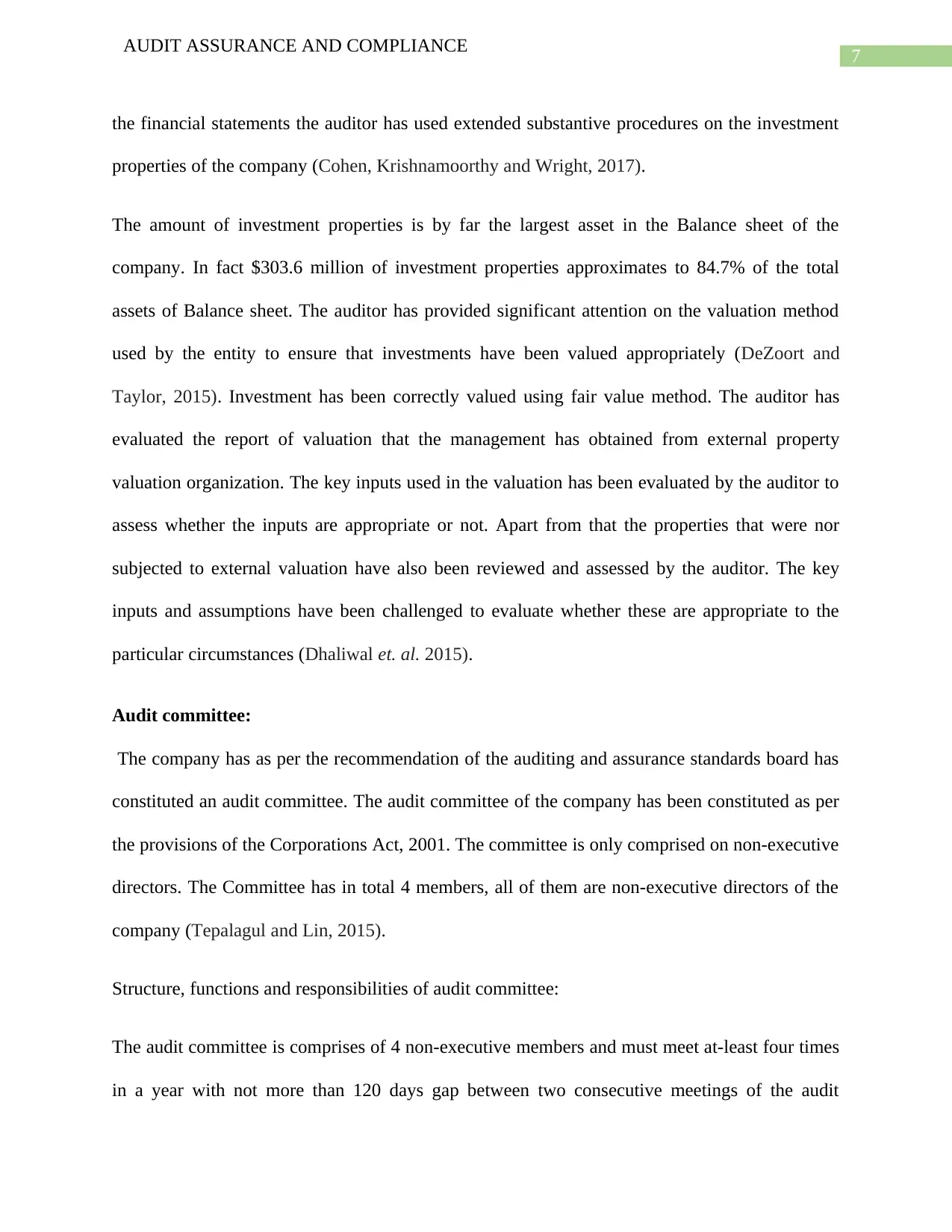
7
AUDIT ASSURANCE AND COMPLIANCE
the financial statements the auditor has used extended substantive procedures on the investment
properties of the company (Cohen, Krishnamoorthy and Wright, 2017).
The amount of investment properties is by far the largest asset in the Balance sheet of the
company. In fact $303.6 million of investment properties approximates to 84.7% of the total
assets of Balance sheet. The auditor has provided significant attention on the valuation method
used by the entity to ensure that investments have been valued appropriately (DeZoort and
Taylor, 2015). Investment has been correctly valued using fair value method. The auditor has
evaluated the report of valuation that the management has obtained from external property
valuation organization. The key inputs used in the valuation has been evaluated by the auditor to
assess whether the inputs are appropriate or not. Apart from that the properties that were nor
subjected to external valuation have also been reviewed and assessed by the auditor. The key
inputs and assumptions have been challenged to evaluate whether these are appropriate to the
particular circumstances (Dhaliwal et. al. 2015).
Audit committee:
The company has as per the recommendation of the auditing and assurance standards board has
constituted an audit committee. The audit committee of the company has been constituted as per
the provisions of the Corporations Act, 2001. The committee is only comprised on non-executive
directors. The Committee has in total 4 members, all of them are non-executive directors of the
company (Tepalagul and Lin, 2015).
Structure, functions and responsibilities of audit committee:
The audit committee is comprises of 4 non-executive members and must meet at-least four times
in a year with not more than 120 days gap between two consecutive meetings of the audit
AUDIT ASSURANCE AND COMPLIANCE
the financial statements the auditor has used extended substantive procedures on the investment
properties of the company (Cohen, Krishnamoorthy and Wright, 2017).
The amount of investment properties is by far the largest asset in the Balance sheet of the
company. In fact $303.6 million of investment properties approximates to 84.7% of the total
assets of Balance sheet. The auditor has provided significant attention on the valuation method
used by the entity to ensure that investments have been valued appropriately (DeZoort and
Taylor, 2015). Investment has been correctly valued using fair value method. The auditor has
evaluated the report of valuation that the management has obtained from external property
valuation organization. The key inputs used in the valuation has been evaluated by the auditor to
assess whether the inputs are appropriate or not. Apart from that the properties that were nor
subjected to external valuation have also been reviewed and assessed by the auditor. The key
inputs and assumptions have been challenged to evaluate whether these are appropriate to the
particular circumstances (Dhaliwal et. al. 2015).
Audit committee:
The company has as per the recommendation of the auditing and assurance standards board has
constituted an audit committee. The audit committee of the company has been constituted as per
the provisions of the Corporations Act, 2001. The committee is only comprised on non-executive
directors. The Committee has in total 4 members, all of them are non-executive directors of the
company (Tepalagul and Lin, 2015).
Structure, functions and responsibilities of audit committee:
The audit committee is comprises of 4 non-executive members and must meet at-least four times
in a year with not more than 120 days gap between two consecutive meetings of the audit
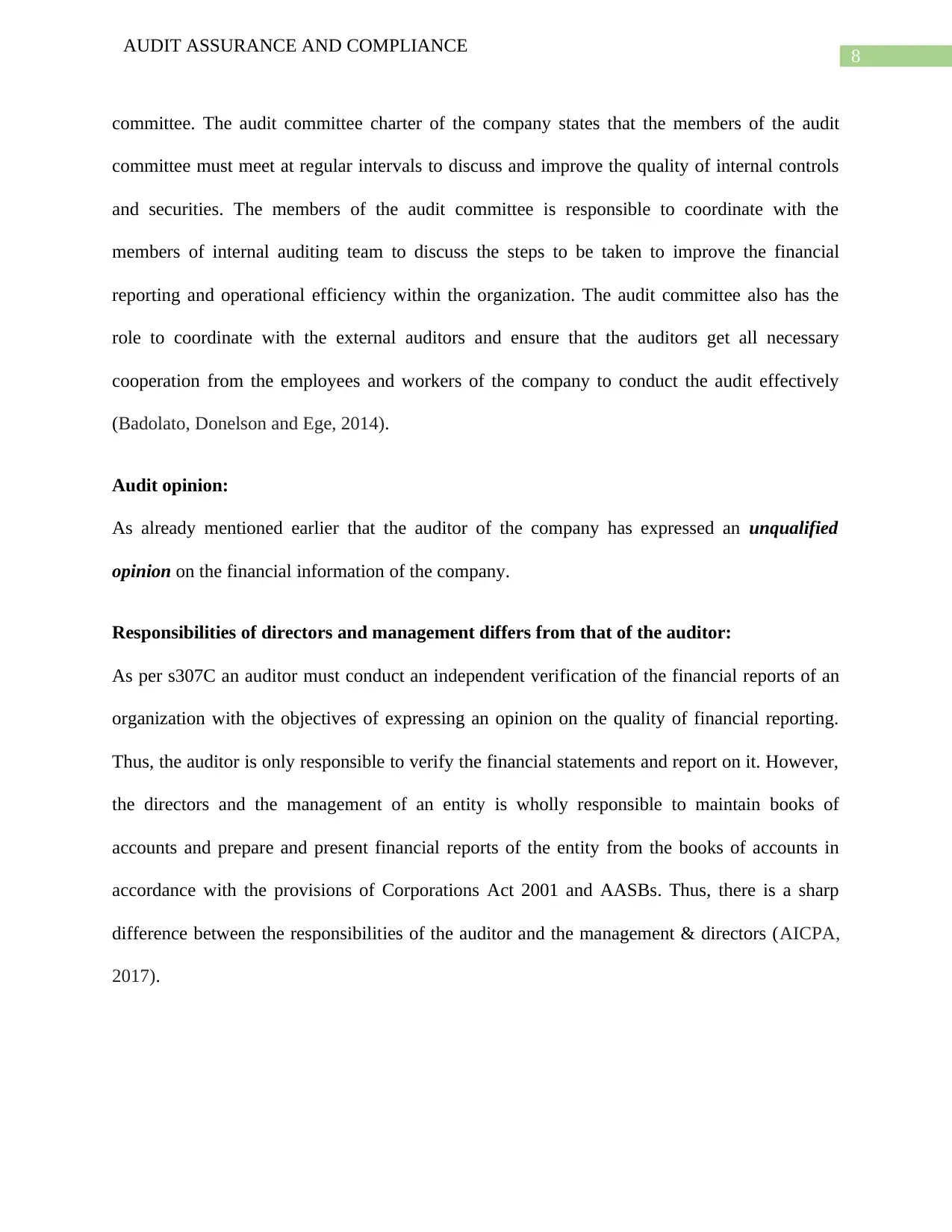
8
AUDIT ASSURANCE AND COMPLIANCE
committee. The audit committee charter of the company states that the members of the audit
committee must meet at regular intervals to discuss and improve the quality of internal controls
and securities. The members of the audit committee is responsible to coordinate with the
members of internal auditing team to discuss the steps to be taken to improve the financial
reporting and operational efficiency within the organization. The audit committee also has the
role to coordinate with the external auditors and ensure that the auditors get all necessary
cooperation from the employees and workers of the company to conduct the audit effectively
(Badolato, Donelson and Ege, 2014).
Audit opinion:
As already mentioned earlier that the auditor of the company has expressed an unqualified
opinion on the financial information of the company.
Responsibilities of directors and management differs from that of the auditor:
As per s307C an auditor must conduct an independent verification of the financial reports of an
organization with the objectives of expressing an opinion on the quality of financial reporting.
Thus, the auditor is only responsible to verify the financial statements and report on it. However,
the directors and the management of an entity is wholly responsible to maintain books of
accounts and prepare and present financial reports of the entity from the books of accounts in
accordance with the provisions of Corporations Act 2001 and AASBs. Thus, there is a sharp
difference between the responsibilities of the auditor and the management & directors (AICPA,
2017).
AUDIT ASSURANCE AND COMPLIANCE
committee. The audit committee charter of the company states that the members of the audit
committee must meet at regular intervals to discuss and improve the quality of internal controls
and securities. The members of the audit committee is responsible to coordinate with the
members of internal auditing team to discuss the steps to be taken to improve the financial
reporting and operational efficiency within the organization. The audit committee also has the
role to coordinate with the external auditors and ensure that the auditors get all necessary
cooperation from the employees and workers of the company to conduct the audit effectively
(Badolato, Donelson and Ege, 2014).
Audit opinion:
As already mentioned earlier that the auditor of the company has expressed an unqualified
opinion on the financial information of the company.
Responsibilities of directors and management differs from that of the auditor:
As per s307C an auditor must conduct an independent verification of the financial reports of an
organization with the objectives of expressing an opinion on the quality of financial reporting.
Thus, the auditor is only responsible to verify the financial statements and report on it. However,
the directors and the management of an entity is wholly responsible to maintain books of
accounts and prepare and present financial reports of the entity from the books of accounts in
accordance with the provisions of Corporations Act 2001 and AASBs. Thus, there is a sharp
difference between the responsibilities of the auditor and the management & directors (AICPA,
2017).
⊘ This is a preview!⊘
Do you want full access?
Subscribe today to unlock all pages.

Trusted by 1+ million students worldwide
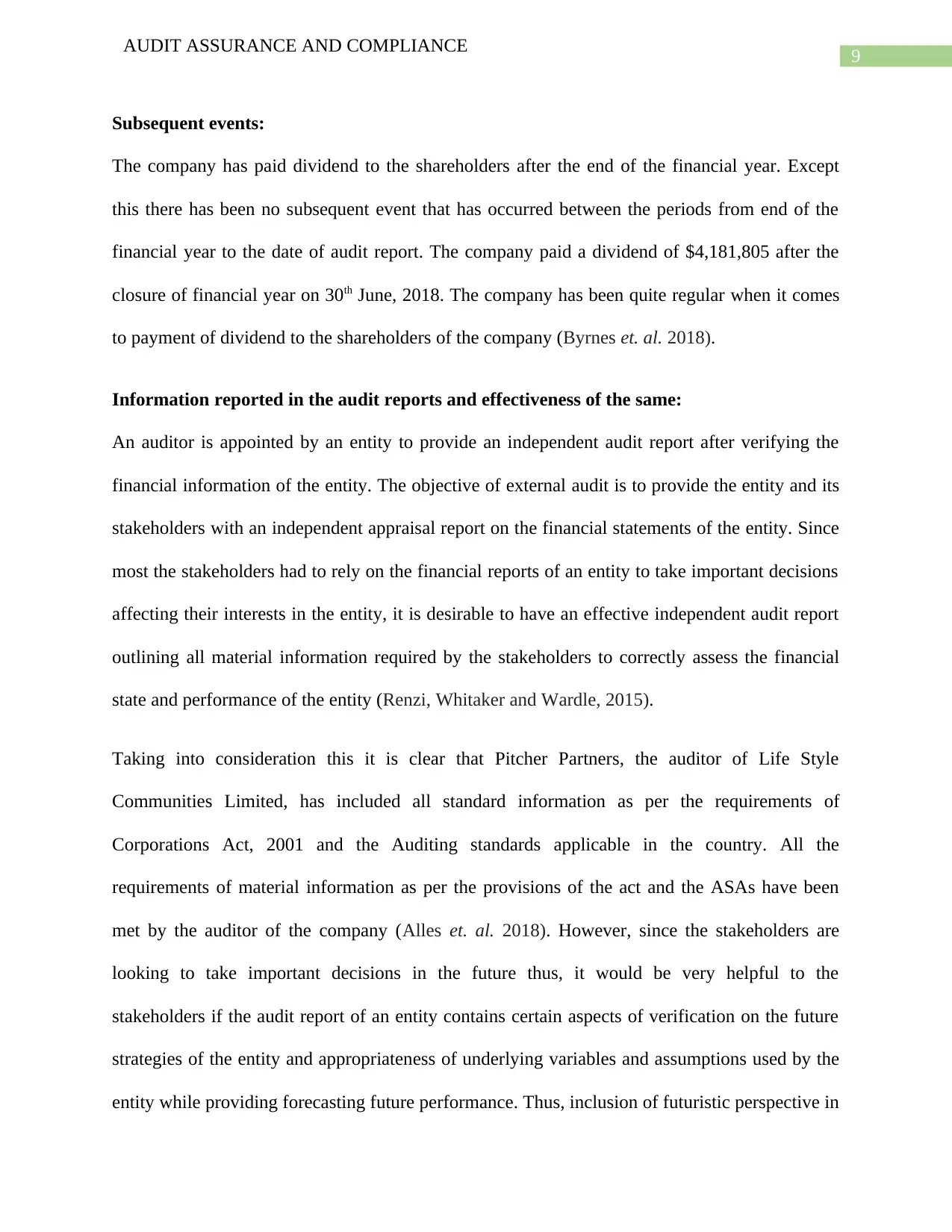
9
AUDIT ASSURANCE AND COMPLIANCE
Subsequent events:
The company has paid dividend to the shareholders after the end of the financial year. Except
this there has been no subsequent event that has occurred between the periods from end of the
financial year to the date of audit report. The company paid a dividend of $4,181,805 after the
closure of financial year on 30th June, 2018. The company has been quite regular when it comes
to payment of dividend to the shareholders of the company (Byrnes et. al. 2018).
Information reported in the audit reports and effectiveness of the same:
An auditor is appointed by an entity to provide an independent audit report after verifying the
financial information of the entity. The objective of external audit is to provide the entity and its
stakeholders with an independent appraisal report on the financial statements of the entity. Since
most the stakeholders had to rely on the financial reports of an entity to take important decisions
affecting their interests in the entity, it is desirable to have an effective independent audit report
outlining all material information required by the stakeholders to correctly assess the financial
state and performance of the entity (Renzi, Whitaker and Wardle, 2015).
Taking into consideration this it is clear that Pitcher Partners, the auditor of Life Style
Communities Limited, has included all standard information as per the requirements of
Corporations Act, 2001 and the Auditing standards applicable in the country. All the
requirements of material information as per the provisions of the act and the ASAs have been
met by the auditor of the company (Alles et. al. 2018). However, since the stakeholders are
looking to take important decisions in the future thus, it would be very helpful to the
stakeholders if the audit report of an entity contains certain aspects of verification on the future
strategies of the entity and appropriateness of underlying variables and assumptions used by the
entity while providing forecasting future performance. Thus, inclusion of futuristic perspective in
AUDIT ASSURANCE AND COMPLIANCE
Subsequent events:
The company has paid dividend to the shareholders after the end of the financial year. Except
this there has been no subsequent event that has occurred between the periods from end of the
financial year to the date of audit report. The company paid a dividend of $4,181,805 after the
closure of financial year on 30th June, 2018. The company has been quite regular when it comes
to payment of dividend to the shareholders of the company (Byrnes et. al. 2018).
Information reported in the audit reports and effectiveness of the same:
An auditor is appointed by an entity to provide an independent audit report after verifying the
financial information of the entity. The objective of external audit is to provide the entity and its
stakeholders with an independent appraisal report on the financial statements of the entity. Since
most the stakeholders had to rely on the financial reports of an entity to take important decisions
affecting their interests in the entity, it is desirable to have an effective independent audit report
outlining all material information required by the stakeholders to correctly assess the financial
state and performance of the entity (Renzi, Whitaker and Wardle, 2015).
Taking into consideration this it is clear that Pitcher Partners, the auditor of Life Style
Communities Limited, has included all standard information as per the requirements of
Corporations Act, 2001 and the Auditing standards applicable in the country. All the
requirements of material information as per the provisions of the act and the ASAs have been
met by the auditor of the company (Alles et. al. 2018). However, since the stakeholders are
looking to take important decisions in the future thus, it would be very helpful to the
stakeholders if the audit report of an entity contains certain aspects of verification on the future
strategies of the entity and appropriateness of underlying variables and assumptions used by the
entity while providing forecasting future performance. Thus, inclusion of futuristic perspective in
Paraphrase This Document
Need a fresh take? Get an instant paraphrase of this document with our AI Paraphraser
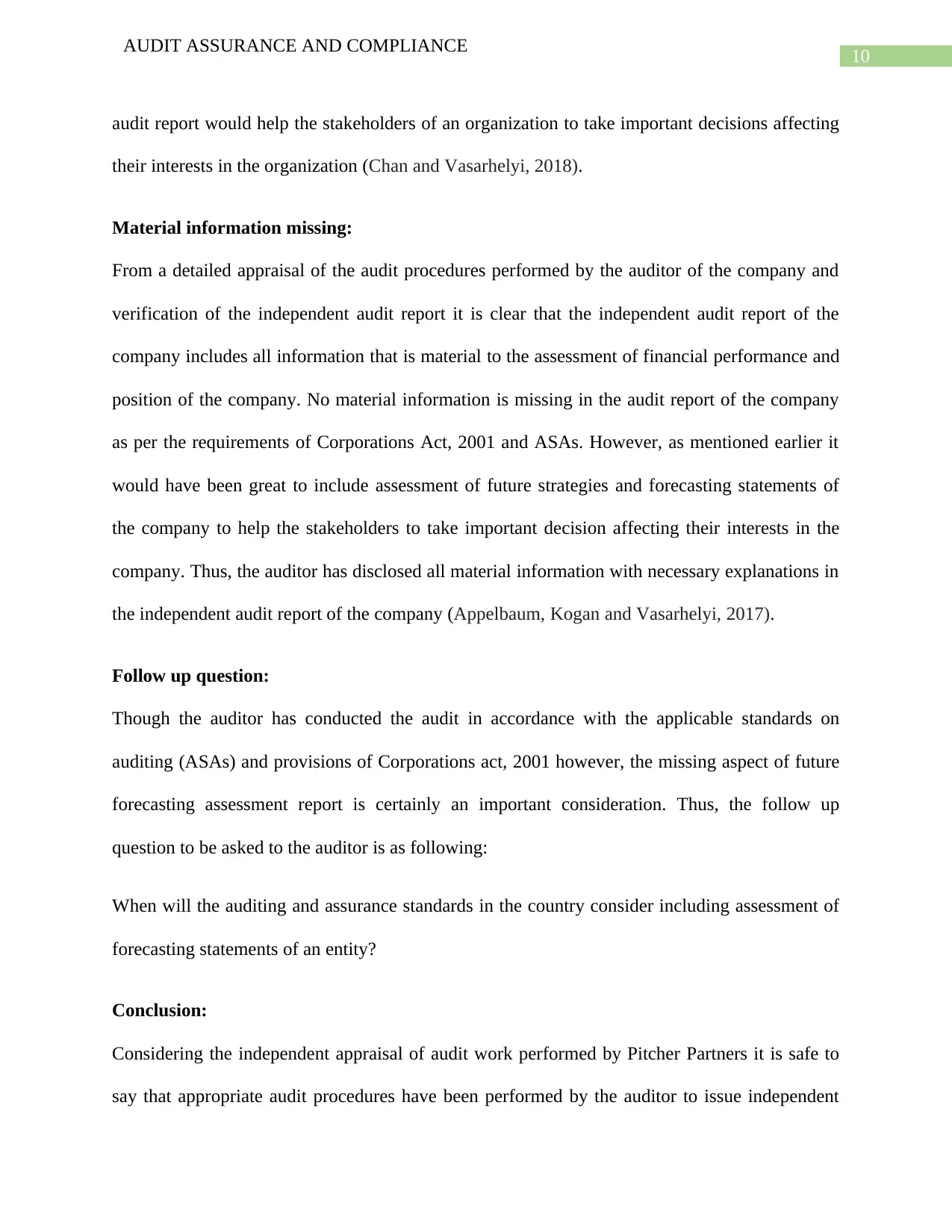
10
AUDIT ASSURANCE AND COMPLIANCE
audit report would help the stakeholders of an organization to take important decisions affecting
their interests in the organization (Chan and Vasarhelyi, 2018).
Material information missing:
From a detailed appraisal of the audit procedures performed by the auditor of the company and
verification of the independent audit report it is clear that the independent audit report of the
company includes all information that is material to the assessment of financial performance and
position of the company. No material information is missing in the audit report of the company
as per the requirements of Corporations Act, 2001 and ASAs. However, as mentioned earlier it
would have been great to include assessment of future strategies and forecasting statements of
the company to help the stakeholders to take important decision affecting their interests in the
company. Thus, the auditor has disclosed all material information with necessary explanations in
the independent audit report of the company (Appelbaum, Kogan and Vasarhelyi, 2017).
Follow up question:
Though the auditor has conducted the audit in accordance with the applicable standards on
auditing (ASAs) and provisions of Corporations act, 2001 however, the missing aspect of future
forecasting assessment report is certainly an important consideration. Thus, the follow up
question to be asked to the auditor is as following:
When will the auditing and assurance standards in the country consider including assessment of
forecasting statements of an entity?
Conclusion:
Considering the independent appraisal of audit work performed by Pitcher Partners it is safe to
say that appropriate audit procedures have been performed by the auditor to issue independent
AUDIT ASSURANCE AND COMPLIANCE
audit report would help the stakeholders of an organization to take important decisions affecting
their interests in the organization (Chan and Vasarhelyi, 2018).
Material information missing:
From a detailed appraisal of the audit procedures performed by the auditor of the company and
verification of the independent audit report it is clear that the independent audit report of the
company includes all information that is material to the assessment of financial performance and
position of the company. No material information is missing in the audit report of the company
as per the requirements of Corporations Act, 2001 and ASAs. However, as mentioned earlier it
would have been great to include assessment of future strategies and forecasting statements of
the company to help the stakeholders to take important decision affecting their interests in the
company. Thus, the auditor has disclosed all material information with necessary explanations in
the independent audit report of the company (Appelbaum, Kogan and Vasarhelyi, 2017).
Follow up question:
Though the auditor has conducted the audit in accordance with the applicable standards on
auditing (ASAs) and provisions of Corporations act, 2001 however, the missing aspect of future
forecasting assessment report is certainly an important consideration. Thus, the follow up
question to be asked to the auditor is as following:
When will the auditing and assurance standards in the country consider including assessment of
forecasting statements of an entity?
Conclusion:
Considering the independent appraisal of audit work performed by Pitcher Partners it is safe to
say that appropriate audit procedures have been performed by the auditor to issue independent
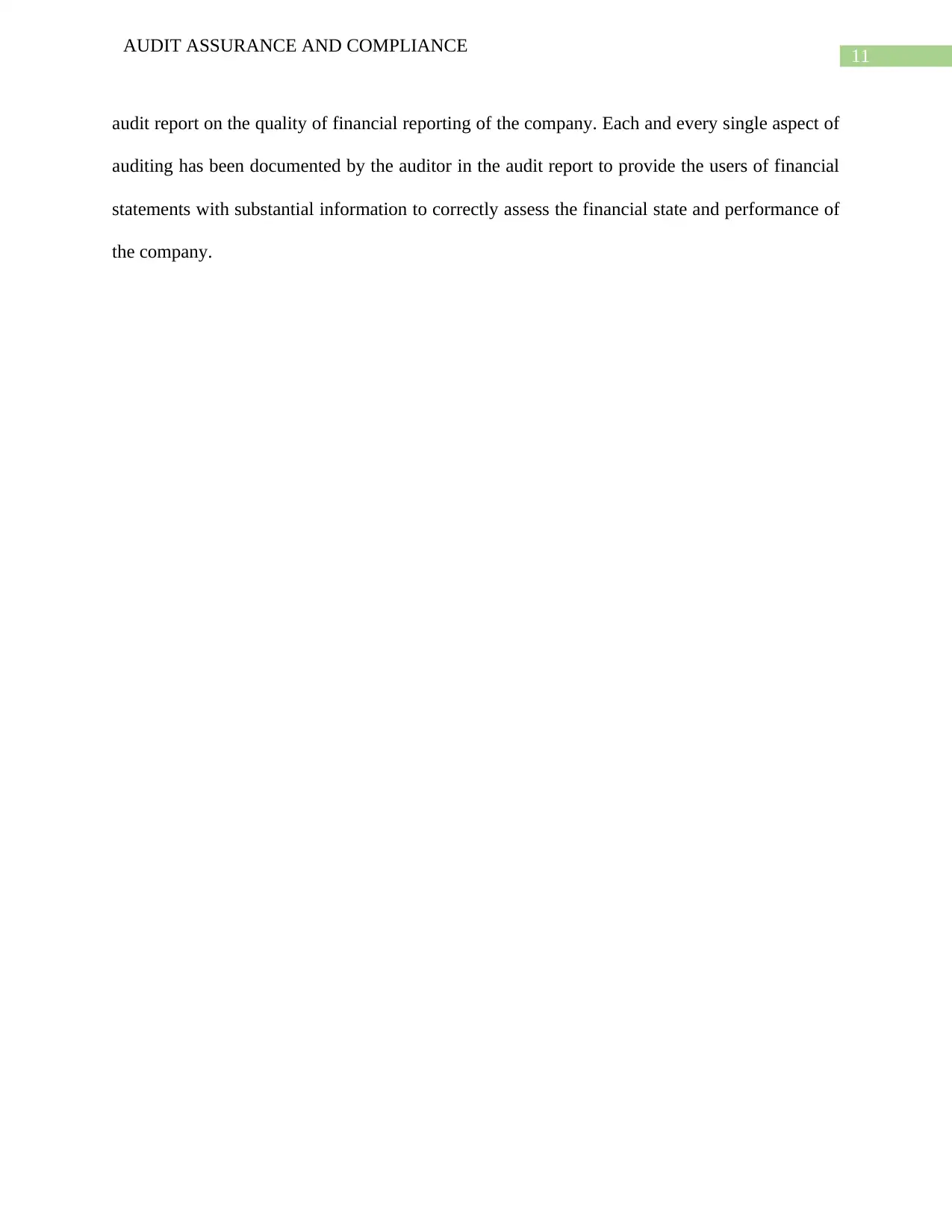
11
AUDIT ASSURANCE AND COMPLIANCE
audit report on the quality of financial reporting of the company. Each and every single aspect of
auditing has been documented by the auditor in the audit report to provide the users of financial
statements with substantial information to correctly assess the financial state and performance of
the company.
AUDIT ASSURANCE AND COMPLIANCE
audit report on the quality of financial reporting of the company. Each and every single aspect of
auditing has been documented by the auditor in the audit report to provide the users of financial
statements with substantial information to correctly assess the financial state and performance of
the company.
⊘ This is a preview!⊘
Do you want full access?
Subscribe today to unlock all pages.

Trusted by 1+ million students worldwide
1 out of 16
Related Documents
Your All-in-One AI-Powered Toolkit for Academic Success.
+13062052269
info@desklib.com
Available 24*7 on WhatsApp / Email
![[object Object]](/_next/static/media/star-bottom.7253800d.svg)
Unlock your academic potential
Copyright © 2020–2025 A2Z Services. All Rights Reserved. Developed and managed by ZUCOL.

